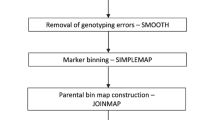Abstract
Haploid linkage analysis of eastern white pine, Pinus strobus L., was carried out using mainly RAPD markers and microsatellite, or simple-sequence-repeat, markers. Ninety one loci mapped to 12 linkage groups of three or more markers. The resulting framework genome map, the first for a soft pine species, contained 69 markers. The map covered 58% of the estimated genome length of 2071 cM(K), with a 95% confidence interval of 1828–2242 cM(K). A systematic comparison of linkage data from eastern white pine, longleaf pine (P. palustris Mill.) and maritime pine (P. pinaster Ait.), gave genome-length estimates for all three species very close to either 2000 cM(K) or 2600 cM(H), depending on whether the Kosambi(K) or Haldane(H) map functions, respectively, were employed. Differences among previous pine genome-length estimates were attributed to the divergent criteria used in the methods of estimation, and indicate the need for the adoption of uniform criteria when performing genome-length estimates. Current data suggest that members of the two pine subgenera, which diverged during the late Mesozoic era, have highly conserved rates of recombination.
Similar content being viewed by others
Author information
Authors and Affiliations
Additional information
Received: 5 January 1997/Accepted: 24 January 1997
Rights and permissions
About this article
Cite this article
Echt, C., Nelson, C. Linkage mapping and genome length in eastern white pine (Pinus strobus L.). Theor Appl Genet 94, 1031–1037 (1997). https://doi.org/10.1007/s001220050511
Issue Date:
DOI: https://doi.org/10.1007/s001220050511




